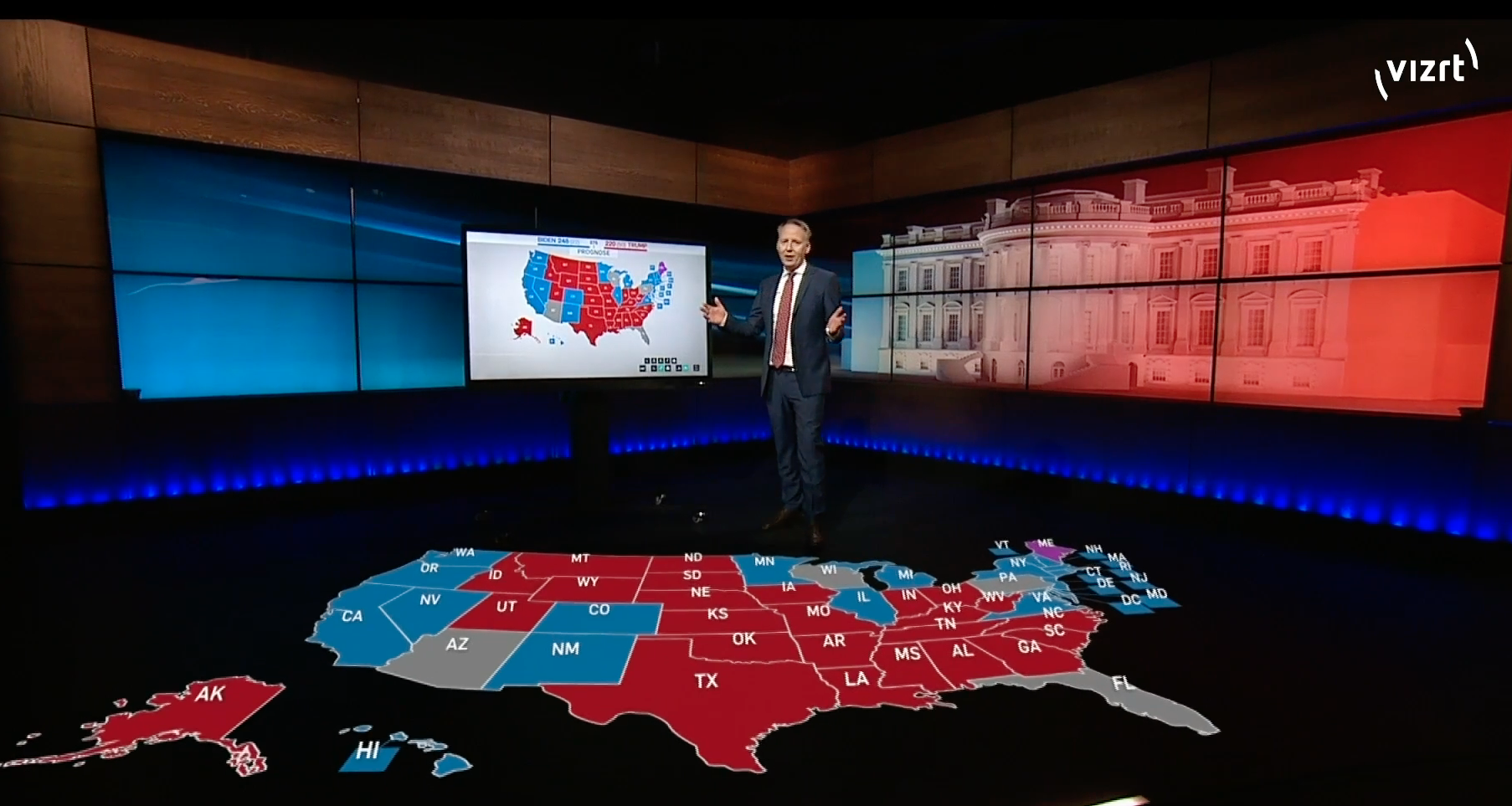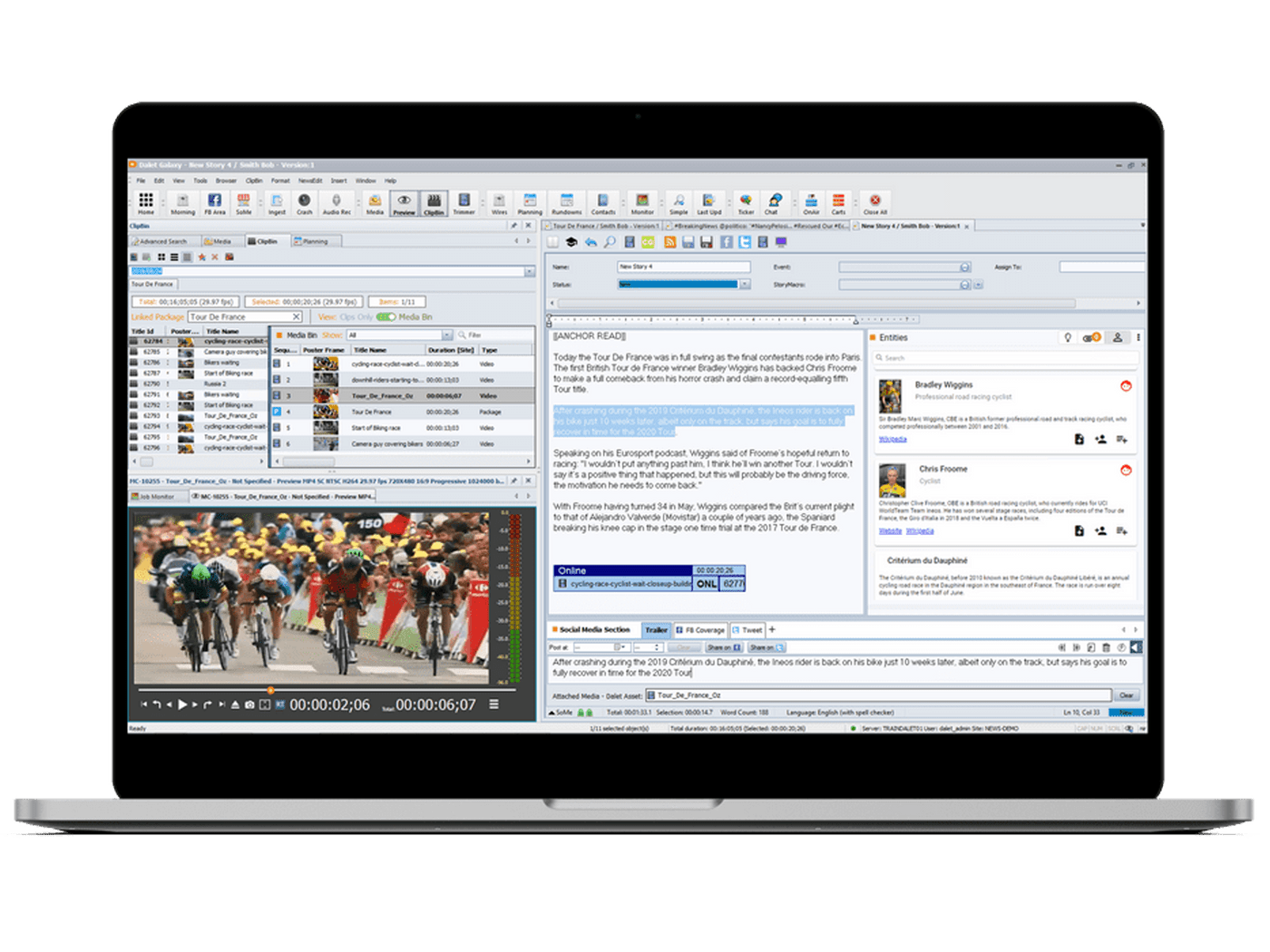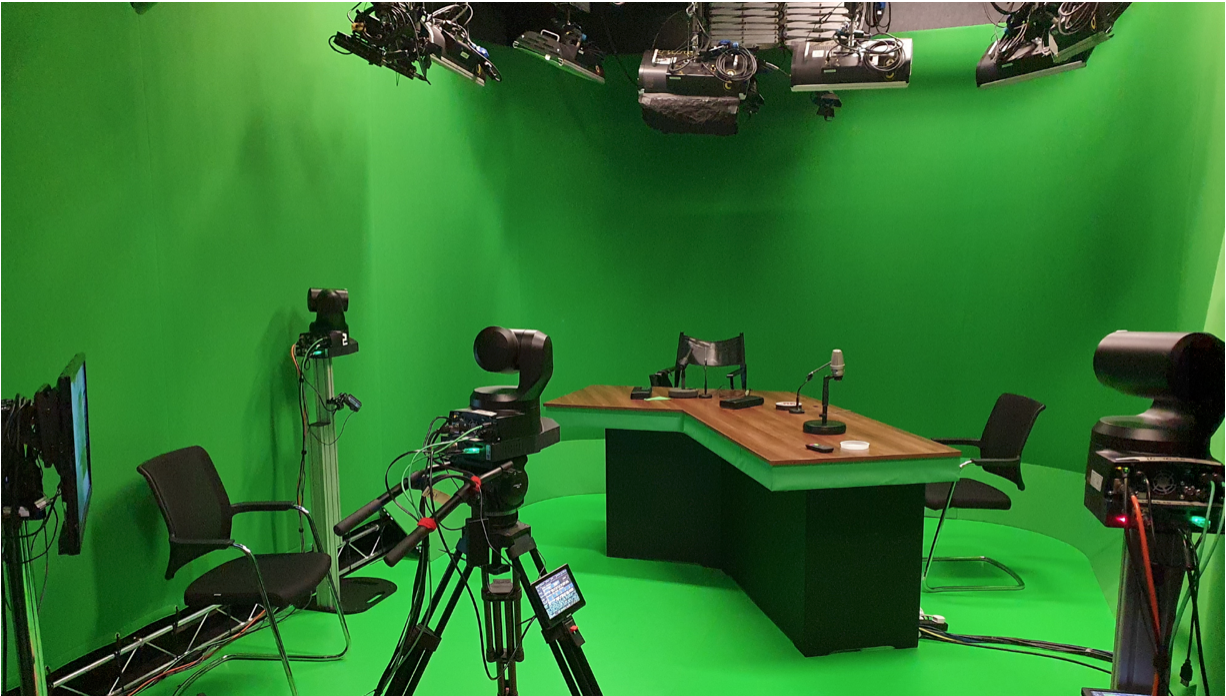The Rapidly Changing Face of TV News Sets
Increased efficiencies, immersive VR sets help to produce more compelling content

SAN FRANCISCO—If the last year has proven anything, it’s that broadcasters are a resilient bunch. In March 2020, when newsroom stations began to be shuttered, news staff scrambled for ideas to pull off productions at home.
Despite some hiccups, many stations across the country pulled off a successful, on-the-fly runaround because newsroom production technologies proved up to the task—the ability to pull in content, edit proxy material, upload graphics, cache locally—all with the final goal of covering breaking news faster even though they weren’t in the newsroom at all.
Consider the obstacles: security restrictions, VPN hurdles and the related problems of less-than-adequate broadband connections, licensing limitations, news workflow disruptions and more. Despite all that, the work needed to be done.
THE CRUCIAL ROLE OF CLOUD
“While anyone can bring an on-premises editor into their house, it’s the team collaboration, news production workflow and management of files that is problematic. There is simply no editorial process or metadata management [in place],” said Raoul Cospen, director of product strategy for news at Dalet.
For any station pushed into a pandemic workaround, access to the cloud proved key as did a way of managing many reporters and editors in multiple locations.
“We had a number of news customers asking for help to support their remote workforces and adjust their infrastructure so that it could support editing from home,” said Bea Alonso, chief market officer at Dalet. The company’s answer to newsroom shutdowns was Dalet Galaxy xCloud, a cloud-based newsroom solution, she said.
The professional video industry's #1 source for news, trends and product and tech information. Sign up below.
“[It] allowed our customers to offload some of their teams to work on Dalet-hosted infrastructure while being away from the physical newsroom,” Alonso said. “Other clients used it as an extension of their on-premise Dalet installation, to provide business continuity to reporters, producers and editors.”
One interesting element about Galaxy xCloud, Alonso said, is that it provides tools familiar to anyone familiar with working in a physical newsroom. This meant there was no additional training required to enable people to produce, edit, write scripts and collaborate with their teams from their homes, Alonso said.
One broadcaster that made quick use of this tool was France Télévisions, the national television network of France, which employed Galaxy xCloud to enable news workflows from home. The SaaS-based system helped facilitate end-to-end remote news production workflows, giving them the flexibility to support remote work for its more than 300 journalists.
In addition to concerns over bandwidth, security and licensing issues, working from home created another speedbump: how does a broadcaster handle team collaboration, news production workflow and management of files when your team is no longer in the same room?
By working with Amazon Web Services and their cloud capabilities, Galaxy xCloud securely connected staff at home to the Dalet Galaxy five on-premise media asset management system. This gave journalists during the pandemic access to tools like the Dalet OneCut news editor so they could search the production system, collaborate with producers and edit growing files.

“It’s seamless integration whether you are at home, in the newsroom or in the field,” Cospen said.
News organizations also tapped into new mobile applications such as the Dalet On-the-Go mobile newsroom application, which enables a remote reporter to connect to their newsroom with a mobile device and write scripts, upload content to the newsroom and use the mobile device as a teleprompter.
“User demand during the pandemic accelerated the development of this mobile app,” Alonso added.
GOING VIRTUAL
But newsroom production technology wasn’t the only tool that stepped into the abyss during the early days of the pandemic.
When U.K. radio station talkRADIO wanted to create video programming to stream online alongside its radio programming, it considered using a virtual set system, but this was made trickier by the fact that guests had to stay socially distanced while in the studio or had to call in by Zoom.
“We were looking at innovative solutions to engage our audiences and satisfy our advertisers, over and above what other radio broadcasters are doing,” said Nick Prater, head of broadcast technology for Wireless Group Media, which operates 11 radio stations in the U.K. “We determined that virtual studio technology was now mature and could provide the unique advantage we needed.”
The answer turned out to be a StarTracker Studio virtual system from Mo-Sys. The broadcaster only had a small space to convert into a studio, Prater said, “but we wanted it to look big, to look luxurious,” he said. As part of the virtual set, talkRADIO installed Panasonic PTZ cameras and the Unreal Engine from Epic Games running on standard HP workstations.
The system is combined with a preconfigured rack of switching, keying and the graphics power to sustain photorealistic virtual environments in real time. Using three tracked cameras—one on a rolling tripod, one on rails and one on a jib —customers can set up a variety of shots and scale up to 16 cameras.
PARTY OF ONE
Beyond the new realities imposed by the pandemic, advanced visual storytelling remains a key goal for many newsroom systems. Vizrt’s Newsroom Solution Suite, a cross-platform newsroom content creation system, allows journalists to independently prepare, script, plan and create with graphics, video, stills, data visualizations and maps. With this system, one journalist can be a one-person production crew.
Journalists can scale and adjust the tools they need based on the volume of required output and the type of content needed for a specific platform, and can also create data-driven election graphics and submit breaking news stories and publish as needed to different platforms.
That’s the simple reality: The pace of the news cycle has never been faster, said Daniel Nergard, president of Vizrt.
“Today’s journalists need to be able to create on multiple output formats, often at the same time, in order to reach and engage their audience,” he said. Nergard added that Newsroom Suite simplifies workflows and offers easier access to a comprehensive set of tools, making it so that journalists can focus on what matters most: Telling the story.
“Vizrt Newsroom allows journalists to scale and adjust the tools they need to the volume of required output and produce any type of content for any kind of show, program or platform,” said Gerhard Lang, CTO for Vizrt. “Content production teams can create anything from data-driven election graphics and breaking news stories, to social media aggregation, and republish and adapt to any combination of output needs.”
Using Vizrt Newsroom’s browser-based interfaces, journalists can plan, create and edit stories from either their newsroom, the road or from home. This feature proved vital during the early days of the pandemic.
“During the pandemic we saw creative use of virtual technology not only from broadcasters but also the corporate world,” said Andre Torsvik, head of marketing strategy for Vizrt Group, referring to a corporate event organized by Janssen, an immunology company that saw its Covid-19 vaccine receive emergency use authorization in the U.S. in early 2021.
The three-day corporate event took place using Vizrt virtual environments. The company used Viz Arc to control graphics and handle virtual camera transitions. All material was produced in the Amazon Web Services cloud and controlled from three international locations, Torsvik said.
“We have seen some brilliant work from our customers in leveraging software-based solutions to break through old hardware-based limitations,” he said.
Vizrt also recently released the Vizrt XR Extended Reality system, which gives journalists virtual, augmented, mixed and extended reality storytelling capabilities. Used in the studio or at a home location, the virtual set can be reset from one show to the next in a matter of minutes. A wall at home can serve as a blank canvas allowing for interaction between presenters and graphics objects.
According to Nergard, the system is designed to make it easier to run immersive, extended reality shows. State-of-the-art camera tracking and AI keying technology create hyper-real, precise graphics. Virtual views, 3D camera flights and myriad analysis tools let the presenter break down a sporting event interactively, either by offering insights on a touchscreen or virtually inserted right on the wall.
Susan Ashworth is the former editor of TV Technology. In addition to her work covering the broadcast television industry, she has served as editor of two housing finance magazines and written about topics as varied as education, radio, chess, music and sports. Outside of her life as a writer, she recently served as president of a local nonprofit organization supporting girls in baseball.


